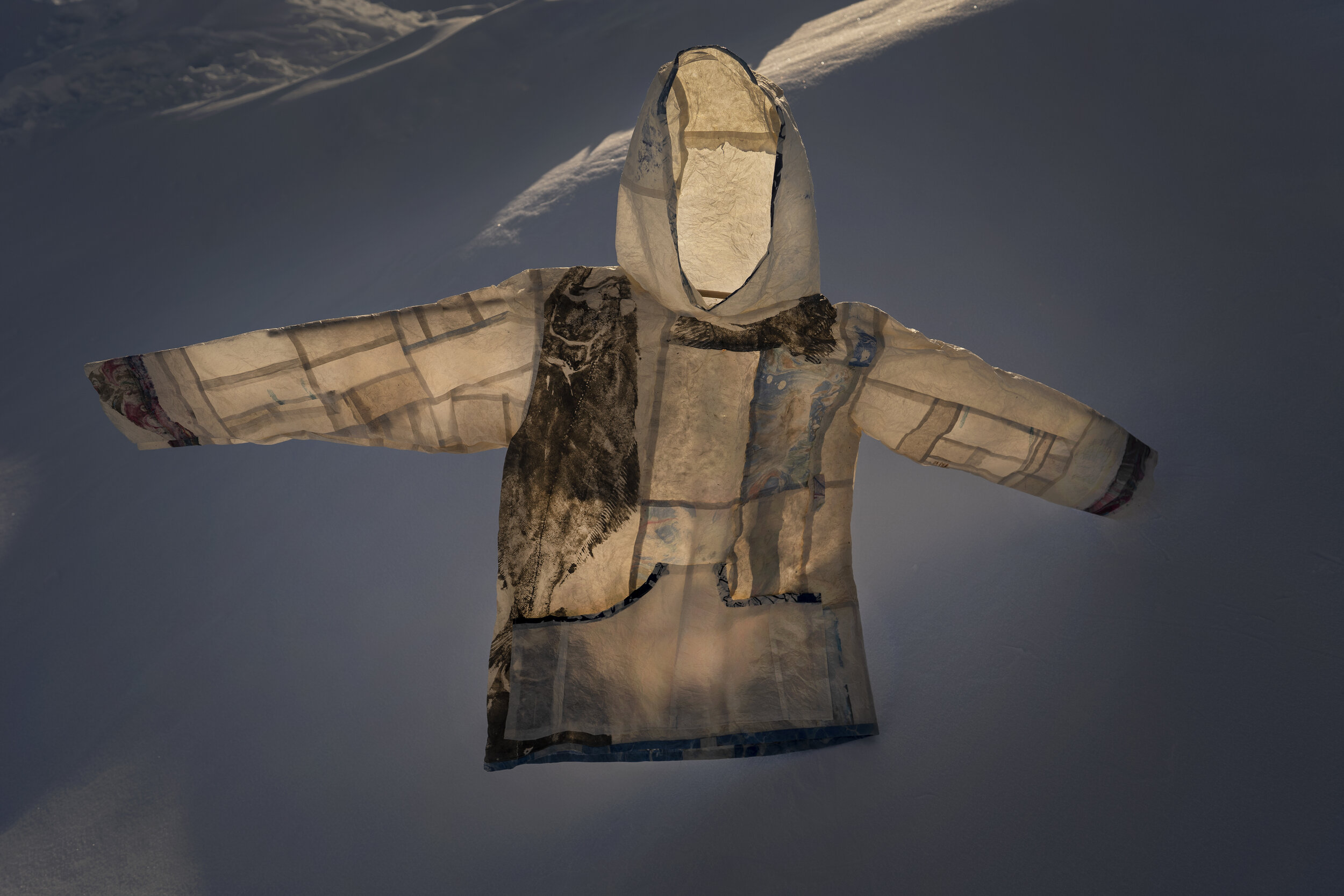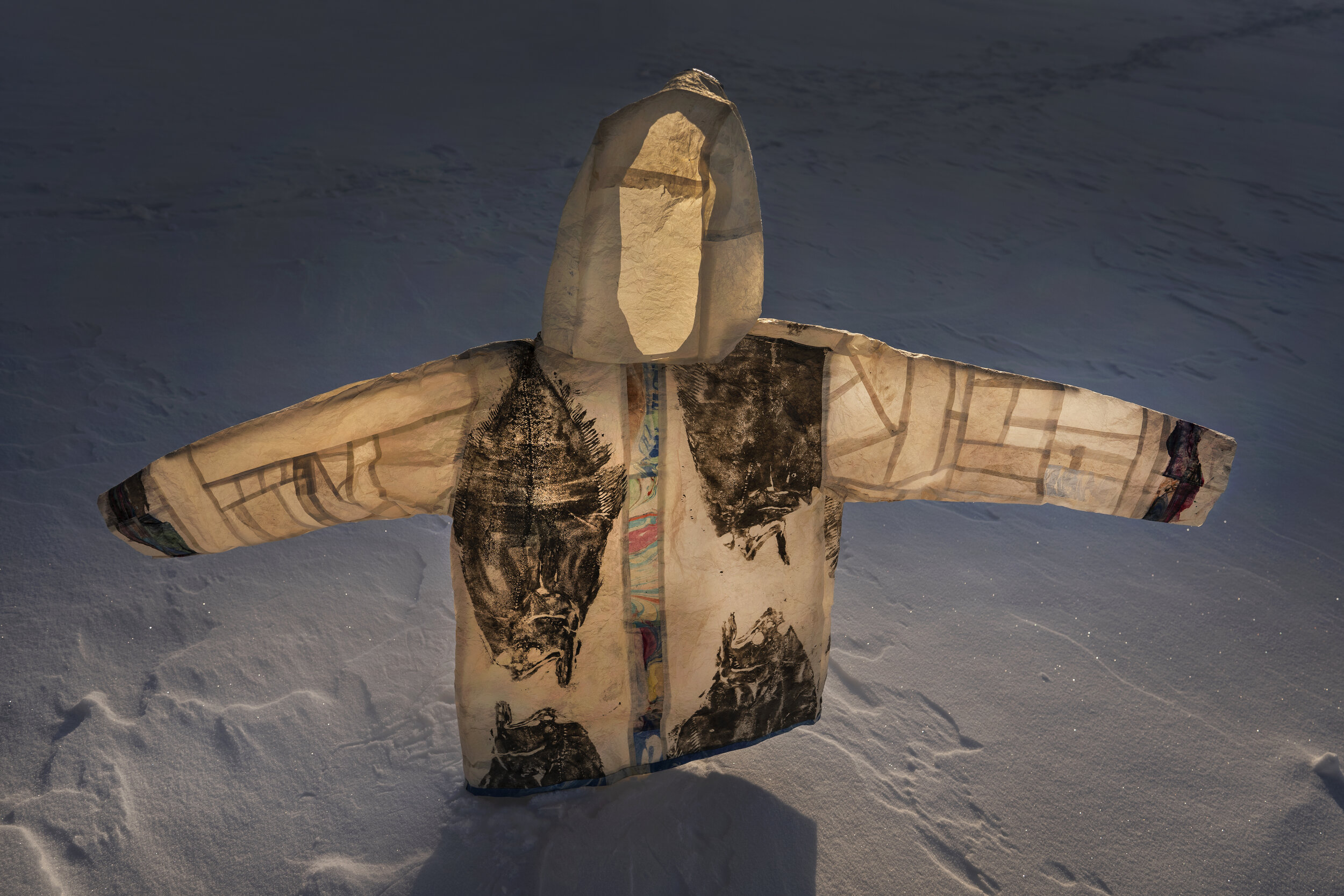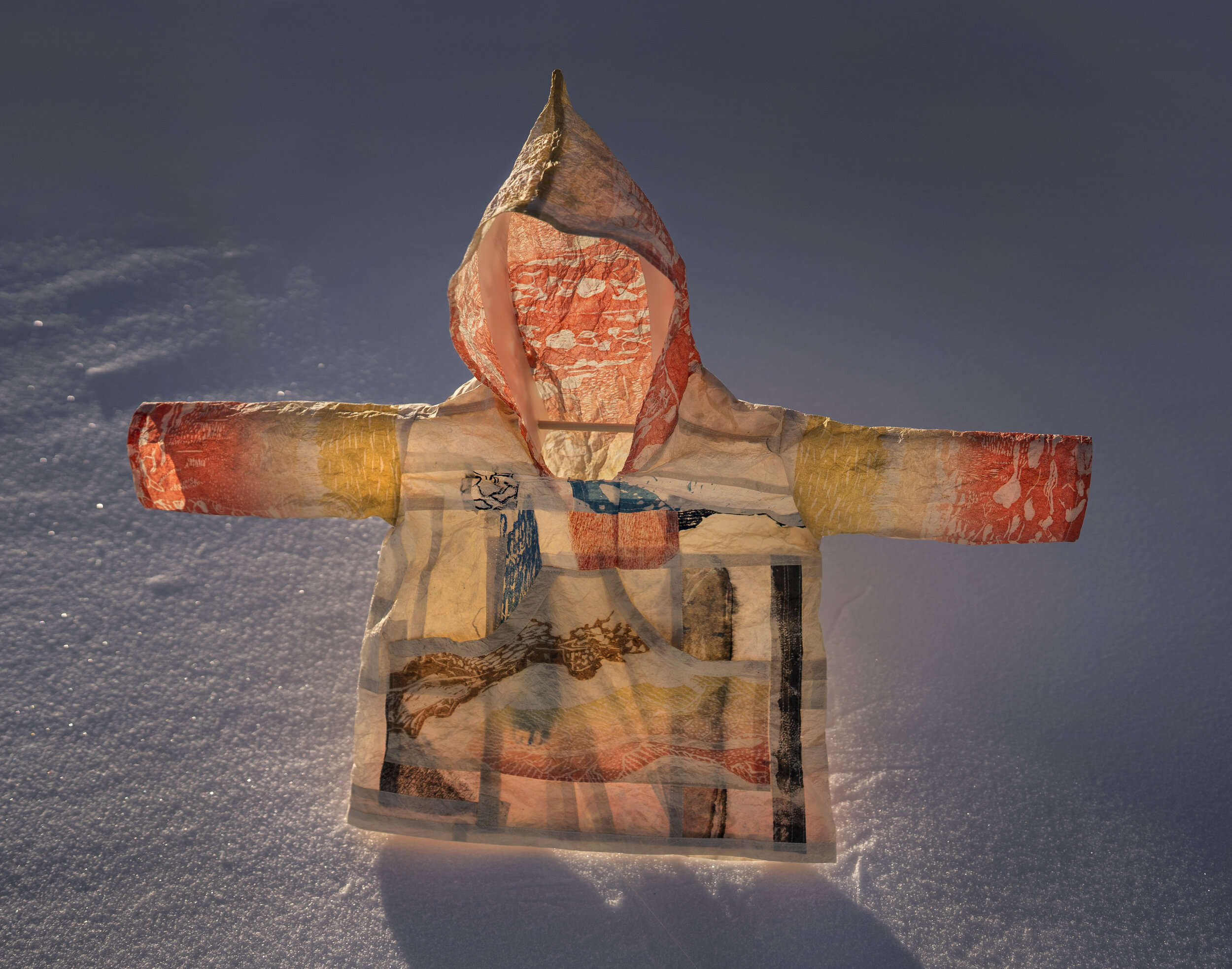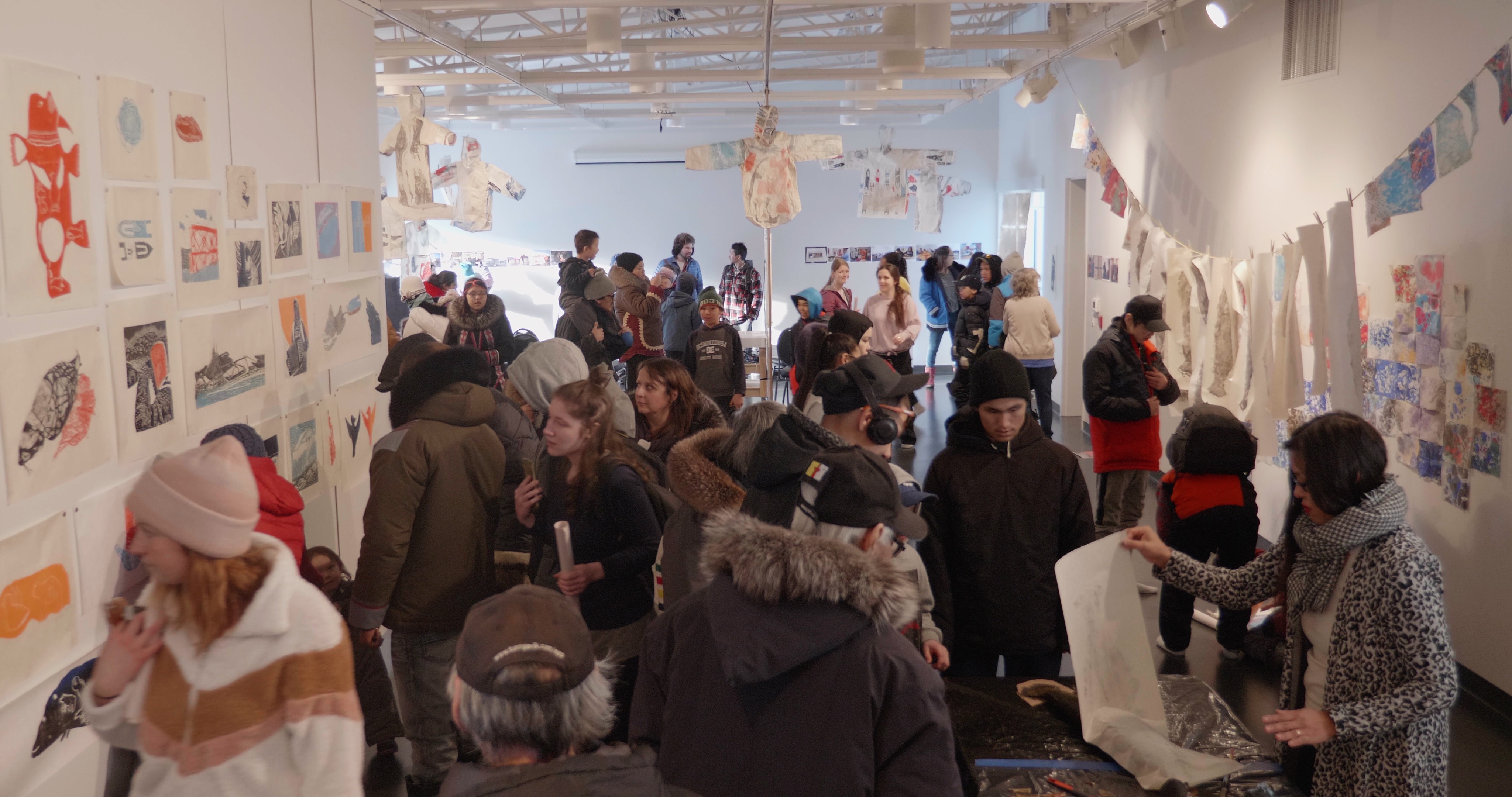ᐊᑎᒌᑦ, ᓯᓚᐹᑦ Atigiit, Silapaat (2019-2020)
(Inuktitut below)
Part of Arctic: Culture and Climate, group exhibition, The British Museum, London, UK (October 22, 2020-February 21, 2021)
Washi, Seikosen washi, handmade South East Asian papers, sumi and oil-based ink, and forged iron (Baffin Island) ink, installation of ten collaborative garments, 2019–2020
A project by students of Attagoyuk Ilisavik and Peter Pitseolak School, Mary Alikatuktuk, Ooloosie Ashevak, Natalie Baird, Alexa Hatanaka, Flora Shum, Cie Taqiasuk and Nicotye Qimirpik, knowledge-sharers: Poisy Alogut, Ashoona Ashoona, Jesse Arnaqgaq, Adamie Ashevak, Mathewsie Ashevak, Amie Ishulutaq, Jaco Ishulutaq, Lasaloosie Ishulutaq, Maggie Lucy Kilabuk, Eena Kullualik, Siita Saila, Sarah Oshutsiaq, Elis Parr, Temela Pitsiulak, Patrick Thompson, Andrew Qappik, Madeleine Qumuatuq, Quvianaqtuliaq Taqaungai, Neevee Tapaungai and Julien Wallot-Beale—in collaboration with Pangnirtung Land and Climate Program, Pangnirtung District Education Authority, and Kinngait District Education Authority
Kinngait student lead artists: Moe Kelly, Kunu Pudlat
Pangnirtung student lead artists: Damien Ishulutaq, Myra Young
Kinngait student participants: Aggiu Ashevak, Janine Manning, Annie Oshutsiaq, Christine Adamie, David Pudlat, Davidee Killiktee, Dennis Hayward, Iqaluk Ainalik, Iqaluk Quvianaqtuliaq, Ivan Koperqualuk, Johnny Samayualie, Lily Ashoona, Luke Jr Aningmiuq, Manumekalla Shaa, Mia Saffa Manning, Miazie Samayualie, Kilabuk Pitsiulak, Moosie Bell, Napatchie Pitsiulak, Ning Qavavau, Joanasie Atsiaq, Katsua Saila, Qavavau Mangitak, Saaki Nuna, Salomonie Ashoona and Tommy Quvianaqtuliaq.
Pangnirtung student Participants: Lorraine Akulukjuk, Benjamin Qaqqasiq, Sylvia Akalukjuk, Nigel Qumuatuq, Monica Veevee, Andrea Kullualik, Iris Soudluapik, Sheila Akulukjuk, Laura Nuvaqiq, Mikibi Nakashuk, Madison Alivaktuk, Eliyah Michael, Rhoda Nashalik, Moses Kooneeloosie, Douglas Michael, TerryLynn Keenainak, Nigel Evvik, Abigail Mosesee, Olivia Kilabuk, Joanne Nowdlak, Caitlyn Maniapik, Annie Ishulutaq, Joemie Michael and Stacey Alivaktuk
As part of ongoing collective Kinngarni Katujjiqatigiit and Embassy of Imagination (2014-2020)
The artists wish to acknowledge the support of: Peter Pitseolak School, Attagoyuk Ilisavik, Canada Council for the Arts, Kinngait District Education Authority, Pangnirtung District Education Authority, The Japanese Paper Place, Paperhouse Studio, Hamlet of Pangnirtung, Indigenous Services Canada, ARCTIConnexion, Canada Goose, and the Prairie Climate Centre.
Nakurmiik/ Thank you: Mary Pitseolak, Kathy Pelletier, Claude Constantineau, Kinngait Studio



Essay
Text by Natalie Baird, Alexa Hatanaka, and Flora Shum, with quotations: Madeleine Qumuatuq, Moe Kelly, Kunu Pudlat and Ooloosie Ashevak. Published in Arctic: Culture and Climate. Lincoln, A., Cooper, J., & Loovers, J.P.L. (eds), Thames and Hudson.
Atigiit, Silapaat is an embodied response to climate change. The artistic process of creating the work is one of knowledge-sharing and solidarity; strengthening relationships through collective learning. Made collaboratively and inter-generationally by creators and knowledge-keepers from Kinngait and Pangnirtung and culturally diverse artists, the work prioritizes the perspectives of Inuit youth who will inherit and care for their homelands. The process of creating the work involved experiences on-the-land, including navigating the sea ice, to gain knowledge and to observe and record changes to the environment that effect livelihoods and cultural wellbeing. Atigiit, Silapaat builds on historical connections between Kinngait and Pangnirtung, which helped foster the development of printmaking, as well as more recent youth exchanges.
Atigiit are insulated, while silapaat are lighter, single-layer garments. This collective artwork was made by sewing Japanese paper, washi, into Inuit silapaat and hanging the different silapaat together as a single installation. Each silapaa was printed using relief as well as monoprinting processes that take relevant found objects and materials as a printing surface. The garments were made collaboratively across the communities, and in addition youth have made related printed, functional parkas. By this process, youth are simultaneously learning the skills to keep themselves warm on the land while learning to understand the land and ice, and to observe changes to support adaptation and resilience.
I feel it is important for kids to learn sewing, and enjoy it as I do, so that they can learn to provide warm clothing for themselves, their families, and earn income. It is important for kids to get out on the land and sea ice because it is part of Inuit culture. They need to learn by exploring the land. - Ooloosie Ashevak
The project combines Inuit garments with Japanese craft processes to reconnect youth to the roots and intertwined histories of Nunavut and Japanese printmaking, including the use of washi. Kinngait (Cape Dorset) artists first began working with Japanese printmaking techniques in the mid-1950s and today printmaking remains a popular art form in Nunavut. There are five Inuit communities (including Pangnirtung) that are known for their prints across Canada and globally. Through printmaking, connections between Inuit and Japanese communities continue. In 2002, the Osaki family of papermakers visited Kinngait with the support of the Japanese Paper Place, Toronto. Atigiit, Silapaat acknowledges and nurtures this initial exchange by using the Osaki’s ‘Seikosen’ washi. The artwork engages the craft of momigami (starch-strengthened washi ), which was traditionally used in Japan to create garments, to visually reference the translucent seal gut that is used by Inuit for traditional garments and shelters. Sewn momigami expands printmaking into multi-dimensional sculptures that communicate the relationship between land, families, the elements, our bodies, and community care expressed through sewing for and with others. Paper – in particular east and southeast Asian handmade paper, a material that Nunavummiut artists and participating artists use to record personal, communal, and generational stories and experiences – is also threatened by a changing environment. Atigiit, Silapaat highlights the importance of climate stability to sustain culture and carry forward vital heritage in east and southeast Asia, and Inuit Nunangat (the collective name for Inuit territories in Canada), but also how traditional practices, connected to place, symbiotically support healthy land and communities. The paper silapaat demonstrate the delicate yet durable nature of washi , symbolizing the environment upon which we depend. They are an affirmative gesture that embodies an interconnected, global, transcultural action, akin to what we all must realize to act on climate change.
Creating collaborative artworks is part of a larger, long-term process that fosters reciprocal relationships with Nunavut communities. Both the process and final artworks support ongoing initiatives (Pangnirtung Land and Climate Program and the Kinngait DEA’s Land Program) that engage youth in local ways of learning, complementary to long-standing knowledge sharing through familial, community, and kinship ties.
“I love going out on the land and sea ice because I love fishing and learning new skills. It makes me feel like a true Inuk.” Kunu Pudlat, 14
“For us inuit sea ice is very important because sea ice is our highway and on our highways we get our food, we go hunting and we have fun. The stories of our culture are told by elders and those stories connect the land, the sea and the ice.” Moe Kelly, 15
Through artistic process we strive to build connections by collectively embarking on an innovative and cross-cultural process to produce an outcome, reflective of multiple voices, that is only possible with collaborative efforts. We hope this artwork honours the actions on climate change that have long been led by Inuit communities, informing and inspiring the international public. Global decisions and industry practices continue to threaten the breadth of human expression and ecosystems. As we collectively face an uncertain climate future, we need an immediate change of institutional power and accountability. Through heartfelt, collective efforts, Atigiit, Silapaat aims to contribute to the empowerment of youth, as their generation inherits the burden of a climate changed – calling for reciprocal, global action in solidarity during this time of transformation.
“Art is important, it’s a way of telling our history, and how it’s still relevant today. For our young people, it’s a way of communicating what they cannot express in words. It’s a tool they could use. By using different techniques, maybe they could grasp something, hold on to something, so they have a vision for tomorrow.” spoken by Madeleine Qumuatuq, Pangnirtung artist, part of an interview for “Atigiit, Silapaat”.

Printing at Kinngait Studios with master printer Ashoona Ashoona (left)

Opening day & screening at Kenojuak Cultural Centre, Kinngait, NU, February 2020
Process film
Directed by: Natalie Baird, Alexa Hatanaka, Flora Shum, and Patrick Thompson
Edited by: Natalie Baird
Videography by: Natalie Baird and Patrick Thompson
Music by: Davidee Killiktee and Ameena Bajer-Koulack
Featuring the voices of: David Killiktee, Moe Kelly, Damien Ishulutaq, and Madeleine Qumuatuq.
With additional footage courtesy of:
- Michael Kahn - Threads that Connect Us: Washimakers meet Inuit Artists, Mirror Village Production, with Japanese Paper Place (2002)
- Ian Mauro, Natalie Baird, and David Poisey - Fishing with Our Hands (2016) and interview with Elisapee Ishulutaq (2016)
ᐊᑎᒌᑦ, ᓯᓚᐹᑦ, 2019-2020
ᐊᑎᒌᑦ, ᓯᓚᐹᑦ ᐊᒻᕙᓯ ᐊᕝ ᐃᒫᔾᔨᓃᓴᓐᑯᑦ ᐊᐅᓚᓂᖓᑦ: ᐃᓕᓐᓂᐊᖅᑏᑦ ᐊᑕᒍᔪᒃ ᐃᓕᓴᕐᕕᒻᒥ ᐊᒻᒪᓗ ᐲᑕ ᐱᑦᓯᐅᓛᖅ ᐃᓕᓐᓂᐊᕐᕕᒃ, ᒥᐊᓕ ᐊᓕᖅᑲᑐᖅᑐᖅ, ᐅᓘᓯ ᐋᓯᕙᒃ, ᓈᑕᓕ ᕕᐊᕐᑦ, ᕗᓗᐊᕋ ᓴᒻ, ᓰ ᑕᕐᕆᐊᓱᒃ, ᓂᑯᑦᑕᐃ ᕿᒥᖅᐱᒃ, ᐊᓚᒃᓴ ᕼᐊᑕᓇᑲ, ᐊᒻᒪᓗ ᐹᑐᕆᒃ ᑖᒻᓴᓐ; ᖃᐅᔨᒪᓂᕐᒥᒃ ᑐᓴᐅᒪᑎᑦᓯᔩᑦ: ᐄᓇ ᖁᓪᓗᐊᓕᒃ, ᐋᑕᒥ ᐋᓯᕙᒃ, ᐊᓲᓈ ᐊᓲᓈ, ᓯᑖ ᓴᐃᓚ, ᐋᓐᓄᓘ ᖄᐱᒃ, ᔭᐃᒃᑯ ᐃᓱᓗᑕᖅ, ᓛᓴᓘᓯ ᐃᓱᓗᑕᖅ, ᒫᑕᓕᓐ ᖁᒻᒧᐊᖅᑐᖅ, ᐊᒻᒪᓗ ᒫᒋ ᓘᓯ ᕿᓚᕝᕙᖅ − ᑲᑐᔾᔨᖃᑎᖃᖅᓱᑎᒃ ᐸᓐᓂᖅᑑᒥ ᓄᓇᒥᒃ ᓯᓚᒥᓪᓗ ᐃᓕᓐᓂᐊᕐᑎᑦᓯᔨᓂᒃ, ᐸᓐᓂᖅᑑᕐᒥ ᑭᙵᕐᓂᓗ ᐃᓕᓐᓂᐊᖅᑐᓕᕆᔨᒃᑯᑦ ᑲᑎᒪᔨᖏᑦ.
ᑭᙵᕐᓂ ᓯᕗᓕᖅᑐᑦ ᐃᓕᓐᓂᐊᖅᑏᑦ ᓴᓇᐅᒐᕐᓂᕐᒥᒃ: ᒨ ᑭᓕ, ᑯᓄ ᐳᓪᓚᑦ, ᐸᓐᓂᖅᑑᕐᒥ ᓯᕗᓕᖅᑐᑦ ᓴᓇᐅᒐᖅᑏᑦ: ᑕᐃᒥᐊᓐ ᐃᓱᓗᑕᖅ, ᒪᐃᕋ ᔭᖕ
ᑭᙵᕐᓂ ᐃᓕᓐᓂᐊᖅᑏᑦ ᐃᓚᒋᔭᐅᔪᑦ: ᐊᒡᒋᐅᖅ ᐋᓯᕙᒃ, ᔭᓃᓐ ᒫᓂᖕ, ᐊᓂ ᐅᓱᑦᓯᐊᖅ, ᑯᕆᔅᑏᓐ ᐋᑕᒥ, ᑕᐃᕕᑎ ᐳᓪᓚᑦ, ᑕᐃᕕᑎ ᕿᓕᖅᑎ, ᑕᓂᔅ ᕼᐊᐃᕗᑦ, ᐃᖃᓗᒃ ᐊᐃᓐᓇᓕᒃ, ᐃᖃᓗᒃ ᖁᕕᐊᓇᖅᑐᓕᐊᖅ, ᐃᐊᓐ ᖁᐱᕐᕈᐊᓗᒃ, ᔮᓂ ᓵᒻᒪᔪᐊᓕ, ᓕᓕ ᐊᓲᓈ, ᓘᒃ ᔪᓂᐊ ᐊᓐᓂᕐᒥᐅᖅ, ᒪᓄᒥᑲᓪᓚ ᓵ, ᒥᐊ ᓵᕙ ᒫᓂᖕ, ᒥᐊᓕ ᓵᒻᒪᔪᐊᓕ, ᕿᓚᕝᕙᖅ ᐱᑦᓯᐅᓛᖅ, ᒨᓯ ᕕᐅᓪ, ᓇᐸᑦᓯ ᐱᑦᓯᐅᓛᖅ, ᓂᖕ ᖃᕙᕙᐅᖅ, ᔪᐊᓇᓯ ᐊᑦᓯᐊᖅ, ᑲᑦᓱᐊᖅ ᓴᐃᓚ, ᖃᕙᕙᐅ ᒪᖏᑦᑕᒃ, ᓵᑭ ᓄᓇ, ᓵᓚᒨᓂ ᐊᓲᓈᖅ ᐊᒻᒪᓗ ᑖᒥ ᖁᕕᐊᓇᖅᑐᓕᐊᖅ.
ᐸᓐᓂᖅᑑᕐᒥ ᐃᓕᓐᓂᐊᖅᑏᑦ ᐃᓚᒋᔭᐅᔪᑦ: ᓗᐊᕋᐃᓐ ᐋᑯᓗᒃᔪᒃ, ᕙᓐᔭᒪᓐ ᖃᖅᑲᓯᖅ, ᓯᐅᓪᕕᐊ ᐋᑯᓗᒃᔪᒃ, ᓇᐃᔾᔪᓪ ᖁᒻᒧᐊᑦᑐᖅ, ᒫᓂᑲ ᕕᕕ, ᐋᓐᑐᕆᐊ ᖁᓪᓗᐊᓕᒃ, ᐊᐃᕆᔅ ᓴᐅᓪᓗᐊᐱᒃ, ᓰᓚ ᐋᑯᓗᒃᔪᒃ, ᓗᐊᕋ ᓄᕙᖅᑭᖅ, ᒥᑭᕝᕕ ᓇᑲᓱᒃ, ᒫᑎᓴᓐ ᐊᓕᕙᖅᑕᖅ, ᐃᓚᐃᔭ ᒪᐃᑯᓪ, ᕈᑕ ᓇᓴᓕᒃ, ᒨᓯᓯ ᑯᓂᓕᐅᓯ, ᑕᒡᓚᔅ ᒪᐃᑯᓪ, ᑎᐅᕆᓕᓐ ᑮᓇᐃᓐᓇᖅ, ᓇᐃᔾᔪᓪ ᐃᕕᒃ, ᐋᕕᒋᐅᓪ ᒨᓯᓯ, ᐅᓕᕕᐊ ᕿᓚᕝᕙᖅ, ᔫᐋᓐ ᓇᐅᓪᓚᖅ. ᑲᐃᑦᓕᓐ ᒪᓐᓂᐊᐱᒃ, ᐋᓂ ᐃᓱᓗᑕᖅ, ᔫᒥ ᒪᐃᑯᓪ ᐊᒻᒪᓗ ᓯᑕᐃᓯ ᐊᓕᕙᖅᑕᖅ
ᓴᓇᐅᒐᖅᑏᑦ ᓇᓗᓇᐃᖅᓯᒍᒪᔪᑦ ᐃᑲᔪᖅᑐᖅᑕᐅᓂᕐᒥᓂᒃ ᐲᑕ ᐱᑦᓯᐅᓛᖅ ᐃᓕᓐᓂᐊᕐᕕᒻᒧᑦ, ᐊᑕᒍᔪᒃ ᐃᓕᓴᕕᒃ, ᑲᓇᑕᒥ ᑲᑎᒪᔩᑦ ᓴᓇᐅᒐᕐᓂᓕᕆᓂᕐᒧᑦ, ᑭᙵᕐᓂ ᐃᓕᓐᓂᐊᖅᑐᓕᕆᔨᒃᑯᑦ ᖃᑎᒪᔨᖏᑦ, ᐸᓐᓂᖅᑑᕐᒥ ᐃᓕᓐᓂᐊᖅᑐᓕᕆᔨᒃᑯᑦ ᑲᑎᒪᔨᖏᑦ, ᔮᐸᓃᓯᒃᑯᑦ ᐸᐃᑉᐹᕐᑖᕐᕕᖏᑦ, ᐸᐃᑉᐹᓕᕆᕕᒃ, ᕼᐋᒻᒪᓚᒃᑯᖏᑦ ᐸᓐᓂᖅᑑᑉ, ᓄᓇᖃᖅᑳᖅᓯᒪᔪᓂᒃ ᐱᔨᑦᓯᕋᖅᑏᑦ ᑲᓇᑕᒥ, ᐋᑎᒃ ᑲᓇᒃᓴᓐ (ARCTIConnexion), ᑲᓇᑕ ᒎᔅ (Canada Goose), ᑐᕌᓐᑐᒥ ᓴᓇᐅᒐᕐᓂᒃ ᑕᑯᑦᓴᐅᑎᑦᓯᓂᖅ (Toronto Biennial of Art) ᐊᒻᒪᓗ ᐳᕆᐅᕆ ᓯᓚᓕᕆᕕᒃ (Prairie Climate Centre).
ᓇᑯᕐᒦᒃ: ᔫᓕᐊᓐ ᐅᐊᓚᑦ−ᕕᐅᓪ, ᓯᐊᔭ ᐅᓱᑦᓯᐊᖅ, ᐃᓕᔅ ᐹᕐ, ᒥᐊᓕ ᐱᑦᓯᐅᓛᖅ, ᑳᑎ ᐸᓚᑦᓯᐊᐃ, ᑯᓘᑦ ᑳᓐᔅᑖᓐᑎᓅ, ᑎᒥᓛᖅ ᐱᑦᓯᐅᓛᖅ, ᒫᑎᐅᓯ ᐋᓯᕙᒃ, ᐊᐃᒥ ᐃᓱᓗᑕᖅ, ᔨᓯ ᐊᕐᓇᑲᒃ, ᓲᓴᓐ ᕋᐅᓱᓪ, ᑭᙵᕐᓂ ᑎᑎᖅᑐᒐᕐᕕᒃ
ᐅᐊᓯ (ᔮᐸᓃᓯᒃᑯᑦ ᐸᐃᑉᐹᖓᑦ), ᓯᑯᓴᓐ ᐅᐊᓯ, ᐊᒡᒐᒻᒧᑦ ᓴᓇᐅᒐᖅ ᑕᕆᐅᑉ ᐊᑭᐊᓂᒥᓂᐅᓄᑦ, ᓱᒥ ᐊᒻᒪᓗ ᐅᖅᓱᒥᒃ ᑐᙵᕕᐊᓕᒃ ᑎᑎᖅᑑᒻᒧᑦ ᐃᒪᖅ, ᐊᒻᒪᓗ ᓴᕕᕋᔭᑦᓴᔭᙳᐊᖅ (ᕿᑭᖅᑖᓗᒃ) ᑎᑎᖅᑑᒧᑦ ᐃᒪᖅ, ᐋᖅᑭᑦᑲᐅᓂᖏᑦ ᖁᓕᑦ ᑲᑐᔾᔨᖃᑎᒌᒍᑕᐅᓯᒪᔪᑦ ᐊᓐᓄᕌᑦ, 2019–2020
ᑎᑎᕋᖅᓯᒪᔪᖅ: ᓈᑕᓕ ᕕᐊᕐᑦ, ᐊᓚᒃᓴ ᕼᐊᑕᓇᑲ, ᐊᒻᒪᓗ ᕗᓗᐊᕋ ᓴᒻ, ᐃᓚᒋᔭᐅᑦᓱᑎᒃ ᒨ ᑭᓕ, ᑯᓄ ᐳᓪᓚᑦ ᐊᒻᒪᓗ ᐅᓘᓯ ᐋᓯᕙᒃ.
ᐊᑎᒌᑦ ᓯᓚᐹᑦ ᐊᐅᓚᔾᔭᒋᐊᕈᑕᐅᓯᒪᔪᖅ ᓯᓚᐅᑉ ᐊᓯᔾᔨᐸᓪᓕᐊᓂᖓᓄᑦ. ᓴᓇᐅᒐᕐᓂᕐᒨᖓᔪᖅ ᐊᐅᓚᓂᖓᑦ ᓴᖅᑮᓂᕐᒧᑦ ᓴᓇᐅᒐᕐᓂᒃ ᐃᓚᒋᔭᐅᔪᖅ ᖃᐅᔨᒪᓂᕐᒥᒃ ᑐᓴᖅᑕᐅᑎᑦᓯᓂᕐᒥᒃ ᐊᒻᒪᓗ ᐊᑕᐅᓯᐅᖃᑎᒌᓐᓂᕐᒥᒃ; ᓴᙱᓕᖅᐹᓪᓕᑎᑦᓯᓂᖅ ᑲᓲᒪᓂᐅᔪᓂᒃ ᐃᓕᓐᓂᐊᐸᓪᓕᐊᓂᒃᑯᑦ. ᑲᑐᔾᔨᖃᑎᒌᒍᑕᐅᓯᒪᔪᑦ ᑭᖑᕚᕇᓄᓪᓗ ᓴᓇᔨᐅᔪᓄᑦ ᐊᒻᒪᓗ ᖃᐅᔨᒪᓂᖃᖅᑐᓄᑦ ᑭᙵᕐᓂ ᐊᒻᒪᓗ ᐸᓐᓂᖅᑑᕐᒥ ᐱᖅᑯᓯᕐᒨᖓᔪᓂᒃ ᖃᓄᑐᐃᓐᓇᑦᓯᐊᖅ ᓴᓇᐅᒐᖅᑐᓂᒃ, ᓴᓇᔭᐅᔪᑦ ᓯᕗᓪᓕᐅᔾᔨᔪᑦ ᑕᐅᑐᑦᑕᖏᓐᓂᒃ ᐃᓄᐃᑦ ᐅᕕᒃᑲᐃᑦ ᕿᒪᐃᕕᐅᒍᒫᖅᑐᑦ ᑲᒪᒋᐊᖃᓛᕐᒥᑦᓱᑎᓪᓗ ᐊᖏᕐᕋᒥᓐᓂ ᓄᓇᓂᒃ. ᐊᐅᓚᖤᐅᔪᑦ ᓴᖅᑮᓂᕐᒧᑦ ᓴᓇᐅᒐᕐᓂᒃ ᐱᖃᓯᐅᔾᔨᓯᒪᔪᖅ ᐱᓕᒻᒪᓴᕐᓂᕐᒥᒃ ᐊᓯᓂ, ᐱᖃᓯᐅᑎᑦᓱᑎᒃ ᐃᖏᕐᕋᒋᐊᖃᕐᓂᖅ ᓯᒃᑯᑯᑦ ᑕᕆᐅᒃᑯᑦ, ᖃᐅᔨᒪᓂᖅᑖᖁᓪᓗᒋᑦ ᐅᔾᔨᖅᑐᕐᓗᑎᓪᓗ ᑎᑎᕋᖅᐸᓪᓕᐊᓗᑎᓪᓗ ᐊᓯᔾᔨᕐᓂᐅᔪᓂᒃ ᐊᕙᑎᒧᑦ ᐊᑦᑐᐃᓂᖃᖅᑐᓂᒃ ᐃᓅᓯᕐᒥᒃ ᐊᒻᒪᓗ ᐱᖅᑯᓯᒃᑯᑦ ᖃᓄᐃᙱᓯᐊᕐᓂᕐᒥᒃ. ᐊᑎᒌᑦ, ᓯᓚᐹᑦ ᐱᕈᖅᐸᓪᓕᐊᒍᑎᖃᖅᓯᒪᔪᑦ ᐱᐅᓯᐅᓯᒪᔪᖅᑎᒍᑦ ᑲᓱᖅᓯᒪᓂᖏᓐᓂᒃ ᑭᙵᐃᑦ ᐊᒻᒪᓗ ᐸᓐᓂᖅᑑᖅ, ᐃᑲᔪᕐᓂᖃᖅᓱᑎᒃ ᐱᕈᖅᐸᓪᓕᐊᓂᖓᓄᑦ ᐱᕙᓪᓕᐊᓂᖓᑕ ᑎᑎᖅᑐᒐᓕᐅᕐᓂᐅᑉ, ᐊᒻᒪᓗ ᒫᓐᓇᖃᕐᒥᐅᓂᖅᓴᖅ ᐅᕕᒃᑲᐃᑦ ᑕᐅᖅᓰᓂᕆᕙᑦᑕᖏᑦ.
ᐊᑎᒌᑦ ᐃᑭᐊᒥᓖᑦ, ᓯᓚᐹᑦ ᓵᓐᓂᖅᓴᐅᑦᓱᑎᒃ ᐃᓗᐱᐊᖃᙱᑦᑐᑦ ᐊᓐᓄᕌᑦ. ᑖᒃᑯᐊ ᑲᑐᔾᔨᖃᑎᒌᒍᑕᐅᓯᒪᔪᑦ ᓴᓇᐅᒐᐃᑦ ᓴᓇᔭᐅᓯᒪᔪᑦ ᒥᖅᓱᖅᓱᑎᒃ ᔮᐸᓃᓯᒃᑯᑦ ᐸᐃᑉᐹᑦᓴᔭᖏᓐᓂᒃ, ᐅᐊᓯ, ᐃᓄᓐᓄᑦ ᓯᓚᐹᕈᖅᓱᑎᒃ ᓂᕕᙵᖅᑎᖅᑕᐅᓯᒪᑦᓱᑎᓪᓗ ᐊᔾᔨᒌᙱᑦᑐᑦ ᓯᓚᐹᑦ ᑐᑭᓕᕇᑦᓱᑎᒃ. ᐊᑐᓂᑦ ᓯᓚᐹᑦ ᑎᑎᖅᑐᒐᕐᕕᐅᓯᒪᔪᑦ ᐊᒻᒪᓗ ᑎᑎᖅᑐᒐᓕᐅᕐᓂᕐᒧᑦ ᐊᐅᓚᓂᖃᕐᕕᐅᓯᒪᑦᓱᑎᒃ ᐊᑑᑎᒋᐊᓕᓐᓂᒃ ᓱᓇᑐᐃᓐᓇᕐᓂᒃ ᑎᑎᖅᑐᒐᓕᐅᕐᕕᖃᖅᓱᑎᒃ. ᐊᓐᓄᕌᑦ ᓴᓇᔭᐅᓯᒪᔪᑦ ᑲᑐᔾᔨᖃᑎᒌᒍᑕᐅᑦᓱᑎᒃ ᓄᓇᓕᓕᓐᓄᑦ, ᐊᒻᒪᓗ ᐅᕕᒃᑲᐃᑦ ᐊᑦᑐᐊᔪᓂᒃ ᑎᑎᖅᑐᒐᓕᐅᖅᓯᒪᔪᑦ ᐊᑎᒋᐅᒍᓐᓇᓪᓚᕆᑦᑐᓄᑦ. ᑕᕝᕘᓇ ᐊᐅᓚᓂᖅᑎᒍᑦ, ᐅᕕᒃᑲᐃᑦ ᐊᑕᐅᑦᓯᒃᑯᑦ ᐃᓕᓐᓂᐊᓯᓐᓈᖅᑐᑦ ᓱᓇᓕᐅᕈᓐᓇᕐᓂᕐᒥᒃ ᐅᖅᑰᔾᔪᑎᑦᓴᒥᓂᒃ ᐊᓯᓃᓕᕈᓂ ᐃᓕᓐᓂᐊᓯᓐᓈᓪᓗ ᓄᓇᒥᒃ ᓯᑯᒥᓪᓗ, ᐅᔾᔨᖅᑐᕐᓗᑎᓪᓗ ᐊᓯᔾᔨᐸᓪᓕᐊᔪᓂᒃ ᐃᑲᔪᖅᓯᒍᑎᑦᓴᓂᒃ ᐃᕕᖅᑎᓂᕐᒧᑦ ᐊᓐᓇᒍᓐᓇᕐᓂᕐᒧᓪᓗ.
ᐱᒻᒪᕆᐅᒋᒐᒃᑯᓪᓕ ᓄᑕᖅᑲᑦ ᒥᖅᓱᕆᐅᕆᐊᖃᕐᓂᖏᑦ, ᖁᕕᐊᒋᓗᒍᓗ ᑕᐃᒫᒃ ᖁᕕᐊᒋᒐᒃᑯᑦᑕᐅᖅ, ᓇᒻᒥᓂᖅ ᐅᖅᑰᔪᓂᒃ ᐊᓐᓄᕋᔾᔨᐅᒍᓐᓇᖅᓯᖁᓪᓗᒋᑦ, ᐃᓚᒥᓐᓂᒃ, ᐊᒻᒪᓗ ᑮᓇᐅᔭᓕᐅᕈᑎᒋᓗᒍ. ᐱᒻᒪᕆᐅᕗᖅ ᓄᑕᖅᑲᑦ ᐊᓯᓄᐊᖃᑦᑕᕐᓂᖏᑦ ᑕᕆᐅᕐᓗ ᓯᑯᖓᓄᑦ ᐃᓚᒋᒪᔾᔪᑦ ᐃᓄᐃᑦ ᐱᖅᑯᓯᖓᑦᑕ. ᐃᓕᓐᓂᐊᕆᐊᓖᑦ ᐊᓯᓅᖃᑦᑕᕐᓗᑎᒃ − ᐅᓘᓯ ᐋᓯᕙᒃ
ᐊᐅᓚᓂᐅᔪᖅ ᐱᖃᓯᐅᔾᔨᔪᖅ ᐃᓄᐃᑦ ᐊᓐᓄᕌᖏᓐᓂᒃ ᔮᐸᓃᓯᒃᑯᑦ ᓴᓇᐅᒐᕐᓂᖏᑦᑕ ᐊᐅᓚᓂᖏᓐᓄᑦ ᑲᓱᖅᑎᑲᓐᓂᖁᓪᓗᒋᑦ ᐅᕕᒃᑲᐃᑦ ᐊᒫᖏᓐᓄᑦ ᐊᒻᒪᓗ ᕿᑉᐹᒪᔪᓄᑦ ᐱᐅᓯᐅᓯᒪᔪᓄᑦ ᓄᓇᕗᒻᒥ ᐊᒻᒪᓗ ᔮᐸᓃᓯᒃᑯᑦ ᑎᑎᖅᑐᒐᓕᐅᕐᓂᖏᓐᓂᒃ, ᐱᖃᓯᐅᑎᑦᓱᓂ ᐊᑐᕐᓂᖅ ᐅᐊᓯᒥᒃ. ᑭᙵᕐᓂ ᓴᓇᐅᒐᖅᑏᑦ ᐊᑐᖃᑦᑕᐸᓕᐊᓯᒪᔪᑦ ᔮᐸᓃᓯᒃᑯᑦ ᐸᐃᑉᐹᓕᐅᕈᓯᖏᓐᓂᒃ ᑖᕙᓂ ᕿᑎᖏᓐᓂ 1950 ᐊᒻᒪᓗ ᐅᓪᓗᒥ ᑎᑎᖅᑐᒐᓕᐅᕐᓂᖅ ᓱᓕ ᐱᐅᒋᔭᐅᓪᓐᓚᕆᑦᑐᖅ ᓴᓇᐅᒐᕐᓂᕐᒧᑦ ᓄᓇᕗᒻᒥ. ᑕᓪᓕᒪᓂᒃ ᐃᓄᓐᓄᑦ ᓄᓇᓕᑦᑕᓕᒃ (ᐱᖃᓯᐅᑎᑦᓱᓂ ᐸᓐᓂᖅᑑᖅ) ᖃᐅᔨᒪᔭᐅᔪᖤᒃ ᑎᑎᖅᑐᒐᓕᐊᖏᓐᓄᑦ ᑲᓇᑕᓕᒫᒥ ᓄᓇᕐᔪᐊᕐᒥᓗ. ᑎᑎᖅᑐᒐᓕᐅᕐᓂᒃᑯᑦ, ᑲᓱᖅᓯᒪᓂᖏᑦ ᐃᓄᐃᑦ ᐊᒻᒪᓗ ᔮᐸᓃᓯᒃᑯᑦ ᓱᓕ ᑲᔪᓯᓯᒪᕗᑦ. 2002−ᖑᑎᓪᓗᒍ, ᐅᓵᑭᒃᑯᑦ ᐃᓚᒌᑦ ᐸᐃᑉᐹᓕᐅᖅᑏᑦ ᓂᐅᕐᕈᔪᔪᑦ ᑭᙵᕐᓄᑦ ᐃᑲᔪᖅᑐᖅᑕᐅᑦᓱᑎᒃ ᐅᑯᓄᖓ ᑕᐃᔭᐅᔪᓄᑦ Japanese Paper Place, ᑐᕌᓐᑐᒦᑦᑐᖅ. ᐊᑎᓖᑦ, ᓯᓚᐹᑦ ᓇᓗᓇᐃᖅᓯᔪᑦ ᐱᕈᖅᓴᐃᓪᓗᑎᓪᓗ ᑖᑦᓱᒥᖓ ᑕᐅᖅᓰᓂᓪᓗᐊᑕᕐᒥᒃ ᐊᑐᖅᓱᑎᒃ ᐅᓵᑭᐅᑉ ‘ᓯᑯᓴ’ ᐅᐊᓯ. ᓴᓇᓲᑦ ᐊᑐᖅᓱᑎᒃ ᒧᒥᒐᒥᒥᒃ (ᕿᕋᑦᑕᖅᑯᑎᒧᑦ ᓴᙱᓕᑎᖅᓯᒪᔪᖅ ᐅᐊᓯ), ᐊᑐᖅᑕᐅᖃᑦᑕᖅᓯᒪᔪᑐᖃᒥᓂᖅ ᔮᐸᓃᓯᒃᑯᓐᓄᑦ ᐊᓐᓄᕋᔾᔨᐅᕈᑕᐅᑦᓱᓂ, ᓲᕐᓗ ᐊᔾᔨᒐᓚᖓ ᓇᑦᓯᐅᑉ ᐃᓇᓗᐊᖓᑕ ᖃᑯᕐᓂᖃᖅᑐᖅ ᐊᑐᖅᑕᐅᓲᖅ ᐃᓄᓐᓄᑦ ᐊᓐᓄᕋᐅᓯᑐᖃᕐᓄᑦ ᐊᖏᕐᕋᑐᖃᕐᓄᓪᓗ. ᒥᖅᓱᖅᓯᒪᔪᑦ ᒧᒥᒐᒥ ᐊᖏᓪᓕᑎᑦᓯᓲᖅ ᑎᑎᖅᑐᒐᓕᐅᕐᓂᕐᒥᒃ ᓵᑦᑐᔮᑐᐃᓐᓇᐅᙱᑦᑐᓂᒃ ᓴᓇᒍᑕᐅᑦᓱᑎᒃ ᑕᑯᓴᑦᐅᑎᑦᓯᔪᓂᒃ ᑲᓲᒪᓂᖏᓐᓂᒃ ᓄᓇᐅᑉ, ᐃᓚᒌᑦ, ᐃᓗᓕᖏᑦ, ᑎᒥᕗᑦ ᐊᒻᒪᓗ ᓄᓇᓕᓐᓂ ᐃᑉᐱᒍᓱᓐᓂᖅ ᑕᑯᑦᓴᐅᑎᑕᐅᑦᓱᓂ ᒥᖅᓱᕈᔾᔨᓂᒃᑯᑦ ᐃᓚᓐᓂᒃ. ᐸᐅᑉᐹᖅ − ᐱᓗᐊᖅᑐᒥᒃ ᑕᕆᐅᑉ ᐊᑭᐊᓂ ᑲᓇᓐᓇᖅᐸᓯᒻᒥ ᐊᒡᒐᒻᒧᑦ ᓴᓇᐅᒐᖅ ᐸᐃᑉᐹᖅ, ᐸᐃᑉᐹᖅ ᐊᑐᖅᑕᐅᓲᖅ ᓄᓇᕗᒻᒥ ᓴᓇᐅᒐᖅᑎᓄᑦ ᐃᓚᐅᔪᓄᓪᓗ ᓴᓇᐅᒐᖅᑎᓄᑦ ᓇᓗᓇᐃᔭᐃᒍᑕᐅᑦᓱᑎᒃ ᐃᒻᒥᓅᖓᔪᓂᒃ, ᓄᓇᓕᓐᓄᑦ ᐊᒻᒪᓗ ᑭᖑᕚᕇᓄᑦ ᐅᓂᒃᑳᓂᒃ ᐊᑑᑎᔭᐅᓯᒪᔪᓂᓪᓗ − ᑕᒪᓐᓇᑦᑕᐅᖅ ᐅᓗᕆᐊᓇᖅᑐᒦᑎᑕᐅᔪᖅ ᐊᓯᔾᔨᐸᓪᓗᐊᔪᒧᑦ ᐊᕙᑎᒧᑦ.
ᐊᑎᒌᑦ, ᓯᓚᐹᑦ ᐊᓚᒡᒐᐃᑎᑦᓯᔪᑦ ᐱᒻᒪᕆᐅᓂᖓᓂᒃ ᓯᓚᐅᑉ ᒪᑭᒪᑦᓯᐊᕆᐊᖃᕐᓂᖓᑕ ᑲᔪᓯᓂᐊᖅᐸᑦ ᐱᖅᑯᓯᖅ ᓯᕗᒧᓪᓗᑎᓪᓗ ᐃᑦᓴᕐᓂᑕᐃᑦ ᑕᕆᐅᑉ ᐊᑭᐊᓂ ᓂᒋᖅᐸᓯᒻᒥ ᑲᓇᓐᓇᖅᐸᓯᒻᒥ, ᐊᒻᒪᓗ ᐃᓄᐃᑦ ᓄᓇᖓᑦ (ᐊᑎᕆᔭᐅᔪᖅ ᐃᓄᓐᓄᑦ ᐊᕕᑦᑐᖅᓯᒪᓃᑦᑐᓄᑦ ᑲᓇᑕᒥ), ᑭᓯᐊᖅᑕᐅᖅ ᐱᖅᑯᓯᐅᑉ ᐊᐅᓚᓂᖏᓐᓂᒃ, ᑲᓱᖅᓯᒪᓂᕐᒥᒃ ᓄᓇᒧᑦ, ᐃᑲᔪᖅᓯᒍᑕᐅᔪᑦ ᖃᓄᐃᙱᓯᐊᕐᓂᒧᑦ ᐊᓯᓂ ᓄᓇᓕᓐᓂᓗ.
ᐸᐃᑉᐹᑦ ᓯᓚᐹᑦ ᑕᑯᑦᓴᐅᑎᑦᓯᔪᑦ ᓯᖁᑦᑎᕆᐊᑭᓐᓂᖓᓂᒃ ᓱᓕᓗ ᐊᑐᕋᑦᓴᐅᑦᓱᓂ ᐅᐊᓯ, ᑕᑯᑦᓴᐅᑎᑦᓯᔪᖅ ᐊᕙᑎᒥᒃ ᓱᖏᖅᑑᑎᒋᔭᑦᑎᓐᓂᒃ. ᐊᖏᖅᓯᒪᓂᖃᖅᑐᑦ ᑲᓱᖅᓯᒪᒍᑕᐅᑦᓱᓂ, ᓄᓇᕐᔪᐊᕐᒧᑦ, ᐊᐅᓚᔾᔭᒋᐊᖃᑎᒌᓐᓂᕐᒧᑦ, ᐅᔾᔨᕆᔭᐃᓐᓇᕆᒋᐊᓕᕗᑦ ᐊᐅᓚᔾᔭᒋᐊᕈᑎᒋᓗᒍ ᓯᓚᐅᑉ ᐊᓯᔾᔨᐸᓪᓕᐊᓂᖓᓄᑦ.
ᓴᖅᑮᓂᖅ ᑲᑐᔾᔨᖃᑎᒌᓐᓂᒃᑯᑦ ᓴᓇᐅᒐᕐᓂᒃ ᐃᓗᓕᖅᑐᓂᖅᓴᖅ, ᐊᑯᓃᖅᑐᒧᑦ ᐊᐅᓚᓂᐅᔪᖅ ᑲᔪᓯᑎᑦᓯᓂᐅᑦᓱᓂ ᑲᓲᒪᖃᑎᒌᓐᓂᐅᔪᓂᒃ ᓄᓇᕗᒻᒥ ᓄᓇᓕᓐᓄᑦ. ᑕᒪᒃᑮᓐᓂ ᐊᐅᓚᓂᖏᓐᓂ ᐱᔭᕇᖅᑐᓂᓪᓗ ᓴᓇᐅᒐᕐᓂ ᐃᑲᔪᖅᑐᐃᔪᑦ ᑲᔪᓯᔪᒥᒃ ᐊᐅᓚᔾᔭᒋᐊᕈᑕᐅᓯᒪᔪᓂᒃ (ᐸᓐᓂᖅᑑᕐᒥ ᓄᓇᒥ ᐊᒻᒪᓗ ᓯᓚᐅᑉ ᐊᓯᔾᔨᐸᓪᓕᐊᓂᖓᓂᒃ ᐃᓕᓐᓂᐊᕐᓂᖅ ᐊᒻᒪᓗ ᑭᙵᕐᓂ ᐃᓕᓐᓂᐊᖅᑐᓕᕆᔨᒃᑯᑦ ᑲᑎᒪᔨᖏᑦᑕ ᐊᓯᓅᖃᑦᑕᕐᓂᕐᒧᑦ ᐊᐅᓚᓂᖓᓂᒃ) ᐃᓚᐅᑎᑦᓯᑦᓱᑎᒃ ᐅᕕᒃᑲᕐᓂᒃ ᓄᓇᓕᓐᓂ ᐃᓕᓐᓂᐊᑎᑦᓯᓂᒃᑯᑦ, ᐃᓚᒍᑦᓯᐅᑎᑦᓱᓂ ᖃᐅᔨᒪᓂᑐᖃᖅ ᐊᒥᖅᑲᐅᑕᐅᔪᖅ ᐃᓚᒌᑦᑎᒍ, ᓄᓇᓕᑦᑎᒍᑦ ᓇᒻᒥᓂᕇᑦᑎᒍᓪᓗ.
“ᐊᓯᓅᕆᐊᑦᓴᖅ ᖁᕕᐊᒋᓗᐊᑦᑕᕋ ᑕᕆᐅᓪᓗ ᓯᑯᖓᓄᑦ ᖁᕕᐊᒋᓪᓚᕆᑲᒃᑯ ᐃᖃᓪᓕᐊᕐᓂᖅ ᓄᑖᓂᓪᓗ ᐱᔭᕆᐅᖅᓴᓂᖅ. ᐃᓄᓪᓚᕆᕐᔫᔮᕐᓂᖅᓴᐅᓕᓲᖑᔪᖓ.” ᑯᓄ ᐳᓪᓚᑦ 14
“ᐅᕙᑦᑎᓄᓪᓕ ᐃᓄᓐᓄᑦ ᑕᕆᐅᖅ ᓯᑯ ᐱᒻᒪᕆᐊᓗᒃ ᓯᑯ ᐊᖅᑯᑎᒋᒐᑦᑎᒍ ᐊᖅᑯᑎᑦᑎᓐᓂᓗ ᓂᕿᑦᓴᖅᑖᓲᖑᒐᑦᑕ, ᐊᓯᕙᖅᓱᑕ ᖁᕕᐊᓇᖅᑐᐊᓘᑦᓱᓂᓗ. ᐅᓂᒃᑳᕆᔭᐅᔪᑦ ᐱᖅᑯᓯᑦᑎᓐᓅᖓᔪᑦ ᐅᓂᒃᑳᖑᔪᑦ ᐃᓄᑐᖃᑦᑎᓐᓄᑦ ᑖᒃᑯᐊ ᐅᓂᒃᑳᖏᑦ ᑲᓱᖅᑎᑦᓯᔪᑦ ᓄᓇᒥᒃ, ᐃᒪᕐᒥᒃ ᓯᑯᒥᓪᓗ.” ᒨ ᑭᓕ, 15
ᓴᓇᙳᐊᕐᓂᐅᑉ ᐊᐅᓚᓂᖓᒍᑦ ᐊᑦᓱᕈᖅᐸᑦᑐᒍᑦ ᐱᕈᖅᐸᓪᓕᐊᑎᑦᓯᑦᓱᑕ ᑲᓲᒪᓂᐅᔪᓂᒃ ᐊᑐᖅᓱᑕ ᓴᓇᑐᓂᕐᒥᒃ ᐊᒻᒪᓗ ᐱᖅᑯᓯᖃᑎᒌᙱᑦᑐᓂᒃ ᓴᖅᑮᒍᑎᒋᓪᓗᒋᑦ, ᑕᑯᑦᓴᐅᑎᑦᓯᔪᒥᒃ ᐊᒥᓱᓂᒃ ᓂᐱᓂᒃ, ᑕᐃᒫᒃ ᑭᓯᐊᓂ ᑲᑐᔾᔨᖃᑎᒌᕝᕕᑦᓴᐅᔪᖅ.
ᑕᒪᓐᓇ ᓴᓇᓂᐅᔪᖅ ᑕᑯᑦᓴᐅᑎᑦᓯᖁᔭᕋᓗᐊᕗᑦ ᐊᐅᓚᔾᔭᒋᐊᕈᑕᐅᔪᓂᒃ ᓯᓚᐅᑉ ᐊᓯᔾᔨᐸᓪᓕᐊᓂᖓᓄᑦ ᐊᑯᓂ ᓯᕗᓕᕈᑕᐅᓯᒪᔪᒧᑦ ᐃᓄᐃᑦ ᓄᓇᓕᖏᓐᓂ, ᑐᓴᐅᑎᑦᓯᑦᓱᑎᒃ ᑲᑦᓱᖓᐃᓵᕆᒍᑕᐅᓪᓗᓂ ᓄᓇᕐᔪᐊᕐᒥ ᑕᐅᑐᑦᑐᓄᑦ. ᓄᓇᕐᔪᐊᕐᒥ ᐋᖅᑭᑦᑕᐅᔪᑦ ᓴᓐᓇᕕᓐᓂᓪᓗ ᐱᐅᓯᐅᕙᑦᑐᑦ ᓱᓕ ᐅᓗᐅᕆᐊᓇᖅᑐᒦᒍᑕᐅᒻᒪᑕ ᐃᓄᓐᓄᑦ ᐆᒪᖃᑎᒌᑦᑐᓄᓪᓗ. ᓵᙵᑦᓯᒐᑦᑕ ᓇᓗᓇᖅᑐᒥᒃ ᓯᓚᐅᑉ ᓯᕗᓂᑦᓴᖓᓂᒃ, ᒫᓐᓇᑦᓴᐅᑎᒋ ᐊᓯᔾᔨᕆᐊᖃᕐᒪᑕ ᑎᒥᐅᔪᓄᑦ ᓴᙱᓂᐅᔪᑦ ᑭᐅᔾᔪᑎᖃᖃᑦᑕᕆᐊᓖᓪᓗ. ᐃᑉᐱᓐᓂᐊᓂᒃᑯᑦ, ᐊᑦᓱᕈᑎᖃᕐᓂᒃᑯᑦ, ᐊᑎᒌᑦ, ᓯᓚᐹᑦ ᑐᕌᒐᖃᖅᑐᖅ ᓴᙱᓂᖅᑖᑎᑦᓯᓂᕐᒥᒃ ᐅᕕᒃᑲᕐᓂᒃ, ᑖᒃᑯᐊ ᕿᒪᐃᕕᐅᒍᒫᕐᒪᑕ ᐅᖁᒪᐃᑦᑐᓂᒃ ᓯᓚᐅᑉ ᐊᓯᔾᔨᕐᓂᖓᓅᖓᔪᓂᒃ, ᐊᐅᓚᔾᔭᒋᐊᖁᔨᔪᑦ, ᓄᓇᕐᔪᐊᕐᒥ ᐊᑕᐅᓯᐅᖃᑎᒌᓐᓂᕐᒥᒃ ᑕᒪᓐᓇ ᐊᓯᔾᔨᐸᓪᓕᐊᓂᖅ ᐊᑑᑎᑎᓪᓗᒍ.
“ᓴᓇᐅᒐᕐᓂᖅ ᐱᒻᒪᕆᐊᓗᒃ, ᐅᓂᒃᑳᖅᑐᖅ ᐱᐅᓯᕆᓯᒪᔭᑦᑎᓐᓂᒃ, ᖃᓄᕐᓗ ᓱᓕ ᐅᓪᓗᒥ ᐊᑑᑎᖃᕐᒪᖔᖅ. ᐅᕕᒃᑲᖁᑎᑦᑎᓐᓄᑦ, ᑐᓴᐅᒪᖃᑦᑕᐅᑎᔾᔪᑎ ᐅᓂᐱᒃᑯᓪᓘᓐᓃᑦ ᐅᖃᐅᓯᕆᒍᓐᓇᖏᑦᑕᖏᓐᓂᒃ. ᐊᖅᑯᑕᐅᒍᓐᓇᖅᑐᖅ ᐊᑐᕈᓐᓇᖅᑕᖓᑦ. ᐊᔾᔨᒌᙱᑦᑐᓂᒃ ᐊᑐᕐᓂᒃᑯᑦ, ᐃᒻᒪᖃ ᓱᓇᒥᒃᑭᐊ ᑎᒍᓯᐊᖅᔪᒍᓐᓇᖅᑐᑦ, ᑎᒍᒥᐊᕐᓗᑎᒃ ᓱᓇᒥᒃᑭᐊᖅ, ᖃᐅᑉᐸᑦ ᓂᕆᐅᒋᔭᖃᖁᓪᓗᒋᑦ.” ᐅᖃᐅᓯᖏᑦ ᒫᑕᓕᓐ ᖁᒻᒧᐊᑦᑐᖅ, ᐸᓐᓂᖅᑑᕐᒥ ᓴᓇᐅᒐᖅᑎ, ᐃᓚᖓᑦ ᐊᐱᖅᓱᕐᓂᐅᔫᑉ ᐅᑯᓄᖓ “ᐊᑎᒌᑦ, ᓯᓚᐹᑦ.”
ᑐᑭᒧᐊᑦᑎᑕᐅᔪᖅ ᐅᑯᓄᖓ: ᓈᑕᓕ ᕕᐊᕐᑦ, ᐊᓚᒃᓴ ᕼᐊᑕᓇᑲ, ᕗᓗᐊᕋ ᓴᒻ ᐊᒻᒪᓗ ᐹᑐᕆᒃ ᑖᒻᓴᓐ
ᓇᑲᑎᕆᔪᖅ: ᓈᑕᓕ ᕕᐊᕐᑦ
ᐊᐅᓚᔫᓕᐅᖅᑐᑦ: ᓈᑕᓕ ᕕᐊᕐᑦ ᐊᒻᒪᓗ ᐹᑐᕆᒃ ᑖᒻᓴᓐ
ᓂᔾᔭᐅᓯᔭᖅᑐᑦ: ᑕᐃᕕᑎ ᕿᓕᖅᑎ ᐊᒻᒪᓗ ᐊᒦᓇ ᕙᐃᔭ−ᑯᓚᒃ
ᑐᓴᖅᓴᐃᑦ ᓂᐱᖏᑦ ᑕᐃᕕᑎ ᕿᓕᖅᑎ, ᒨ ᑭᓕ, ᑕᐃᒥᐊᓐ ᐃᓱᓗᑕᖅ ᐊᒻᒪᓗ ᒫᑕᓕᓐ ᖁᒻᒧᐊᖅᑐᖅ
ᐊᔾᔨᓕᐅᖅᑕᐅᖃᓯᐅᑎᓯᒪᔪᑦ ᐅᑯᓇᙶᙳᐊᑕᖅᓯᓐᓇᖅᑐᖅ:
ᒪᐃᑯᓪ ᑳᓐ − ᐃᕙᓗᐃᑦ ᑲᓱᕈᑎᒋᓯᒪᔭᕗᑦ: ᐸᐃᑉᐹᓕᐅᖅᑏᑦ ᑲᓱᐃᔪᑦ ᐃᓄᓐᓂᒃ ᓴᓇᐅᒐᖅᑎᓂᒃ, Mirror Village Production, ᔮᐸᓃᓯᒃᑯᑦ ᐸᐃᑉᐹᖃᕐᕕᖓᓐᓂᒃ (2002)
ᐃᐊᓐ ᒪᐅᕈ, ᓈᑕᓕ ᕕᐊᕐᑦ, ᐊᒻᒪᓗ ᑕᐃᕕᑦ ᐳᐊᓯ − ᐃᖃᓗᒐᓱᐊᕐᓂᖅ ᐊᒡᒐᑎᓐᓄᑦ (2016) ᐊᒻᒪᓗ ᐊᐱᓱᖅᑎᑕᐅᑎᓪᓗᒍ ᐃᓕᓴᐱ ᐃᓱᓗᑕᖅ (2016)